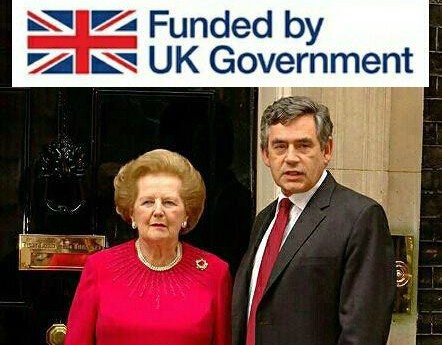It’s been a gaffetastic period for unionist politics on social media. However, this is neither trivial nor ephemeral. Something very big is happening.
On social media, it appears, Scotland is already pretty close to being independent.
Labour has had a rough time: Kezi Dugdale told us all their leaflets were printed in England and reminded us that they failed to save Ravenscraig.
Dear SNP activists moaning about labour leaflets being printed in England, you're building a Scottish bridge with Chinese steel. Love Kez
— Kezia Dugdale (@kdugdalemsp) February 27, 2015
An unfortunate official advised us all to vote Tory to keep out the SNP.
Previously, a candidate tweeted a picture of herself standing outside a health centre, commenting on short staffing. The health centre was, of course, closed and had been replaced by a brand new one next door. (Later explanations about taking the picture there to get the sign in kinda missed the point.)
V interesting visit to Glenwood Health Centre in #Glenrothes w @JennyMarra but clear short-staffing is a big problem pic.twitter.com/D5d142gvu8
— Melanie Ward (@melanie_ward) February 10, 2015
(I take no pleasure in this, by the way. I want to see all progressive parties campaigning effectively on social media – even if I disagree with them about the constitutional arrangements of these islands and even if many progressive friends would dispute that Labour is progressive. I digress…)
But now we have the cherry on the cake – and it’s from the Tories/Lib Dems not Labour. Some marketing genius in the bowels of Whitehall has decided to plaster assorted public works with the slogan “funded by UK government”. No doubt this was supposed to persuade voters not to back “separatist” parties in the general election.
Instead an entirely predictable memeplosion has blasted across Twitter (and Facebook in a different way) north of the Border. You can’t move for images of assorted Westminster-inspired disasters with the label “funded by UK government” slapped on them. This has been very covered by Wings Over Scotland and CommonSpace so I will only present a couple of my favourites.
First we have Maggie and Mr Timetable himself – and image I suspect SNP supporters will be making sure we all see a lot of in the coming months:
Gordon Brown ten un plan #fundedbytheUKGovernment #GE2015 #Scotland #Escocia #UK http://t.co/j4ZuQVniX6 pic.twitter.com/cLfScSlMz8
— Pilar Fernandez (@pilaraymara) March 2, 2015
And we also have a shot of Ravenscraig:
Do the Westminster types never learn? Another marketing #epicfail "@andrewneary: Funded by the UK Government #GE2015 pic.twitter.com/ETFMoyRF8J"
— Stewart Kirkpatrick (@calgacus) March 1, 2015
The interesting thing about all this is that it’s all one way. Labour are mightily outgunned on social media in Scotland. The Tories, despite their enormous Facebook budget, remain irrelevant. Every misstep (or even just every step) they make is spotted, amplified and made hay with almost immediately.
I always tell my clients that, when it comes to political campaigning, the days of off-the-cuff, hit-and-hope tweets are long gone. (Find out more about my services here.)
As a former member of the Yes Scotland senior management team, this rings some bells with me. It’s what used to happen to us on a daily basis in the mainstream press. Everything we did was subjected to intense scrutiny and thrown back at us. We were held accountable for the cock-ups of people on the margins of or outwith the campaign.
As Head of Digital, my job was to focus on the media environment where things were a bit fairer: social media. We educated, informed and enthused our supporters. We sought out, seeded, promoted and encouraged other websites, groups and users.
While Yes Scotland may have been wound up. All those people, groups and websites have not gone away. They remain enthusiastic and committed. The Yes Digital legacy is that social media landscape in Scotland is heavily pro-independence.
Another consequence of the indyref campaign is that a lot of these people who are active online have despaired of traditional media. As customers, it took them for granted. As citizens, they feel it’s skewed the political landscape of their country. Now, they have formed their own digital landscape.
It’s an environment that needs to be treated with more respect than throwing together a trite slogan like “funded by UK government”. Scotland is different.
Proof of this can be found in the extraordinary crowdfunding campaign of Wings Over Scotland. (It’s a little-known fact that whenever you create a blog or website, you are contractually bound to refer to that site with the prefix “controversial”. Regardless of your views of the site’s tone, it is a must-read for anyone interested in Scottish politics.)
Speaking as someone who has started an online publication and knows how difficult funding is, what Stuart Campbell has achieved is utterly astounding. In the space of 24 hours, he raised more than £75,000. (At time of writing the total is £88,000.) A publication which can raise that kind of money in that kind of time is a serious player.
By my reckoning, Stu Campbell has a larger freelance budget than most news and features editors in Scotland.
Not only have a very large number of people of Scotland created their own new media landscape – they’re putting their hands in their pockets to keep it thriving.


 RSS - Posts
RSS - Posts